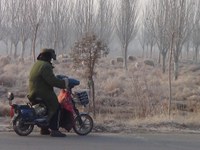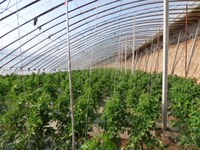Spotlight on Economics: Agriculture in China
(Click an image below to view a high-resolution image that can be downloaded)
By Cheryl Wachenheim, Professor NDSU Department of Agribusiness and Applied Economics
“What is agriculture like in America?” is a question I am asked often by students, scholars and farmers throughout China.
“What is agriculture like in China?” is the most frequent question I field from folks back home. The answer to both is straightforward on the surface; they are very different.
American farms are generally large. The last agricultural census places the average size farm in the United States at 441 acres. The average size in North Dakota is 1,307 acres and in Minnesota is 352 acres. And, in the United States, there is considerable variability in farm size. The average farmer in China farms just 1.4 acres, approximately the size of a football field, and farm size is similar between one farmer and the others in his village.
As you would therefore expect, most Chinese farmers do not use the machinery and equipment you see on American farms. In fact, most use no machinery at all. This spring, farmers planting by hand or with the aid of a draft animal and with pesticide packs strapped on their backs walking their fields were common sights as we rode the train throughout China’s countryside.
Chinese agriculture is quite labor intensive. The concept of a truly labor-intensive productive activity is one I didn’t fully understand until we first witnessed the daily street cleaning that is conducted throughout Beijing by individual men and women using handmade straw brooms. These and other common labor-intensive activities, including farming, seem in stark contrast to the immense cranes working from sunup to sundown constructing skyscrapers in many cities as the Chinese economy grows at an annual rate of 7 percent.
Mechanized is not a word associated with agriculture in China. The expression on the faces of my Chinese students when I describe a 90-foot sprayer or a GPS-driven tractor with a 24-row planter reflects authentic awe. The difference is only due, in part, to differences in topography, so one can imagine one day that mechanized agriculture will be more common in China.
Already, as is the case in many quickly developing countries, the Chinese seem ready to skip ahead in the evolution of agriculture to quickly adopt the newest technologies. For example, surprisingly common as a relatively inexpensive hobby item for those interested in landscape photography, unmanned aerial equipment is already being used to apply these same pesticides in some areas of China.
Labor-intensive farming is well-suited to today’s China because there are plenty of farmers; some 300 million of them. However, these farmers do not enjoy the social and economic position of many of our own 3.2 million farmers. Chinese farmers are generally poor, both in earnings and in wealth. And, their living conditions are rudimentary. In this country where family is first, I am surprised by the number of colleagues and friends who have explained that they return to their to their childhood home alone for the annual fall and spring festivals because their spouse is not comfortable with the standard of living found in this rural farming village.
This typification of Chinese agriculture, including small farms and considerable poverty, is made more challenging by a general lack of education, training and information required to make market-based decisions. While farmers are now free to produce for the market, they often don’t have the information they need to do so. Added is the widespread financial exclusion incurred by Chinese farmers.
Lack of collateral and low incomes place them low on the return/risk scale for financial institutions. Further deterring creditors are transactions costs associated with the small size of farm operations and general lack of verifiable records.
The situation I describe, however, is changing. It will take time, but the potential for growth in agriculture is great. Supported by focused government policy, aided by significant efforts against the corruption that has previously impeded the efficiency of policy aimed at rural development, progress in Chinese agriculture will continue; I suspect at an accelerated pace.
There is plenty proof of this in the countryside as young, hard-working, innovative college-educated Chinese entrepreneurs return to their home villages to drive progress. China has in place programs that work to encourage these high-impact men and women. And, where there is opportunity, especially that supported by an increasingly market-oriented policy that rewards hard work and success, people will capitalize on it and, in doing so, will help rural areas grow economically.
One shining example is Tonghui Agricultural Cooperative in rural Inner Mongolia, an autonomous region of northern China. The cooperative is the result of a dream of Wang Lu, a young man ready to start his career after graduating from Peking University in Beijing.
In his words, Lu returned to his home province because, “President Xi said we should go to our home villages and help the farmers become businessmen, so I came here to help them.”
From an idea formed only two years ago and actioned only last year, the cooperative today boasts more than 330 farmer-members, and provides services to more than 2,000 farmers.
Tonghui Cooperative has successfully engineered a previously nonexistent supply chain for local products, including warehousing, processing and logistics to bring their cooperative-branded, Certified Green raw and processed products to markets throughout Inner Mongolia and to Beijing.
They have established direct market sales to independent and chain supermarkets. Even more notably, they have jumped into the future through their direct marketing to restaurants and home-consumers through three of China’s leading e-commerce platforms. The farmer-members, a majority of whom have never used a computer, find their products moving to store shelves and consumers’ tables in places as far and important as Beijing through internet sales and contracted delivery. This is true progress.
Our agriculture is very different from that found throughout most of China. What is common is the entrepreneurial spirit and strong work ethic of the farmers. I see in the not-too-distant future, farmers throughout China using precision technologies in low-environmental impact production working toward their food security goals associated with feeding the 1.4 billion people of China. I think you will see it as well.
NDSU Agriculture Communication - May 11, 2016
| Source: | Cheryl Wachenheim, 701-231-7452, cheryl.wachenheim@ndsu.edu |
|---|---|
| Editor: | Kelli Armbruster, 701-231-6136, kelli.armbruster@ndsu.edu |




